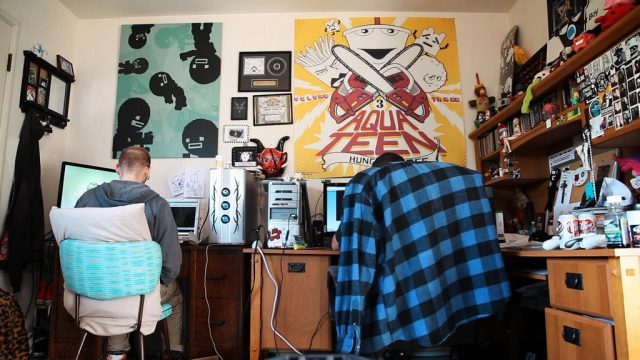Indie Game intertwines three stories of game development, capturing each at a different moment in its production/reception. The documentary has plenty of crunchy technical details–Edmund McMillen explaining the way his Super Meat Boy teaches the player its game mechanics is a great sequence–and discussions of creativity and the personal psychological signature indie creators tend to leave on their games. As an informative look at how successful video games can get made by one or two people driven by Kickstarters, ambition, and Red Bull, it’s worth watching; as an exploration of how deeply personal commercial art can be, it’s at times quite moving.
But one of the most striking things about Indie Game is how it evokes the emotional rollercoaster ride of living by your creativity in the internet era, when public opinion is more immediate, fickle, and accessible than ever. Jonathan Blow, the designer of Braid, a game already a proven success by the time Indie Game was filmed, is in the documentary mainly to talk about the post-release day experience. Braid helped prove that independent games could be critically and commercially successful. Its reviews were positive across the board. But Blow describes feeling a wash of disappointment as reviewer after reviewer praises aspects of the game he thinks are trivial or incidental while ignoring what he felt was most significant and personal. There’s a “world’s smallest violin” feel to it, especially when the movie gets into Blow’s habit of showing up in every comment section–including this one? Let’s find out!–to debate the author’s points… but at the same time, when everyone interviewed is talking about how their games feel dug out of their own souls, there’s something affecting about Blow. If you put a heartfelt message in a bottle and are lucky enough to have it wash up on shore, it’s probably strange to hear people only discussing the bottle manufacturing and the beauty of your calligraphy.
On the other hand, well: art may be communication, but it’s not only communication. The audience has no responsibility, moral or otherwise, to respond to the work in the way its creator intended. Any artist has to accept that–maybe by remembering all the times they’ve been the audience to someone else’s work–just as the price of doing business.
But once upon a time, it wouldn’t have been as easy to turn up thousands of comments about your work, let alone to directly respond to everyone who is Totally Wrong; it certainly wouldn’t have been as easy to then stumble across caricatures of yourself and thinkpiece articles about how you’re a douche. Once anything is out in the world, people get to have opinions about it–but there’s still a definite pang when Blow talks about seeing himself–his name, his image, his persona–become a kind of public property that he has less and less control over.
Also present and dismayed is Phil Fish, the designer of Fez, a game still unreleased at the point Indie Game was made. Fez had debuted its demo years before to massive acclaim and publicity, and as the film opens, Fish is suffering partly from the weight of that success and anticipation. He’s a perfectionist–he describes learning pixel art to work on the game and then finishing it and realizing his skills improved so significantly over the course of the work that the game’s art is now uneven in quality, so he starts all over–and the pressure isn’t helping. People are constantly asking him when the game is coming out… and then they’re losing patience and posting about how terrible he is for not having it done yet and how it’s clearly never going to be finished. When Fish hits a rush of exuberance at an expo because he sees that an article about his latest play test has eleven thousand Facebook likes, there’s mostly just a sense of enormous relief–they still like me! They really still like me!
And then he finds out that that was a glitch. None of the eleven thousand likes ever existed. Not this time.
Still racking up the likes, however, and in the first wave of public approval, are Edmund McMillen and Tommy Refenes, the designers of Super Meat Boy, a platformer about a boy with no skin trying to rescue his girlfriend (who’s made of bandages) while dodging saws that will reduce him to bloody splatter and while scaling up walls by flinging himself against them and sticking there briefly with his general raw hamburger physique. Oh, and the girlfriend was kidnapped by a fetus in a jar, who wears a monocle. It’s quite clear that this is a legitimately personal project for McMillen, one rooted in his own love for his childhood games and sensibilities and also in his own sense of vulnerability; the weird, horror-tinged, gross-out art of his childhood drawings is now completely, ecstatically marketable. There’s no “selling out” going on here, particularly, even though McMillen and Refenes are the most open about consciously thinking of their audience. They’re not churning out product they have no emotional connection to–instead, they’re just lucky enough to have their id-gratifying senses of fun intersect with mass gamer culture. They’re not Fish, trying to explain that he wanted to make a game that feels relaxed and like a nice world to inhabit (or needing to justify another missed release date), or Blow, attempting to fight the internet until it cries uncle and sees and feels the philosophical thrust of his creation. For them, the internet, and its immediately visible consumer reactions, is an exciting gift.
All three games were ultimately successful; all the creators obviously talented. What Indie Game makes clear is what, outside of talent, designers need to keep going–to be an artist, a certain sense of vulnerability, of personal expression; to stay sane, either very good luck or a very invincible ego.
(Indie Game is available on Amazon Prime Video.)


